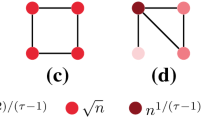Abstract
We study the induced subgraph isomorphism problem on inhomogeneous random graphs with infinite variance power-law degrees. We provide a fast algorithm that determines for any connected graph H on k vertices if it exists as induced subgraph in a random graph with n vertices. By exploiting the scale-free graph structure, the algorithm runs in O(nk) time for small values of k. We test our algorithm on several real-world data sets.
Access this chapter
Tax calculation will be finalised at checkout
Purchases are for personal use only
Similar content being viewed by others
References
Albert, R., Jeong, H., Barabási, A.L.: Internet: diameter of the world-wide web. Nature 401(6749), 130–131 (1999)
Boguñá, M., Pastor-Satorras, R.: Class of correlated random networks with hidden variables. Phys. Rev. E 68, 036112 (2003)
Bollobás, B., Janson, S., Riordan, O.: The phase transition in inhomogeneous random graphs. Random Struct. Algorithms 31(1), 3–122 (2007)
Brach, P., Cygan, M., Łacki, J., Sankowski, P.: Algorithmic complexity of power law networks. In: Proceedings of the Twenty-Seventh Annual ACM-SIAM Symposium on Discrete Algorithms, SODA 2016, pp. 1306–1325. Society for Industrial and Applied Mathematics, Philadelphia (2016)
Britton, T., Deijfen, M., Martin-Löf, A.: Generating simple random graphs with prescribed degree distribution. J. Stat. Phys. 124(6), 1377–1397 (2006)
Chung, F., Lu, L.: The average distances in random graphs with given expected degrees. Proc. Natl. Acad. Sci. USA 99(25), 15879–15882 (2002) (electronic)
Clauset, A., Shalizi, C.R., Newman, M.E.J.: Power-law distributions in empirical data. SIAM Rev. 51(4), 661–703 (2009)
Faloutsos, M., Faloutsos, P., Faloutsos, C.: On power-law relationships of the internet topology. ACM SIGCOMM Comput. Commun. Rev. 29, 251–262 (1999)
Fountoulakis, N., Friedrich, T., Hermelin, D.: On the average-case complexity of parameterized clique. arXiv:1410.6400v1 (2014)
Fountoulakis, N., Friedrich, T., Hermelin, D.: On the average-case complexity of parameterized clique. Theor. Comput. Sci. 576, 18–29 (2015)
Friedrich, T., Krohmer, A.: Cliques in hyperbolic random graphs. In: INFOCOM Proceedings 2015, pp. 1544–1552. IEEE (2015)
Friedrich, T., Krohmer, A.: Parameterized clique on inhomogeneous random graphs. Disc. Appl. Math. 184, 130–138 (2015)
Garey, M.R., Johnson, D.S., Garey, M.R.: Computers and Intractability: A Guide to the Theory of NP-Completeness. W H FREEMAN & CO (2011)
Grochow, J.A., Kellis, M.: Network motif discovery using subgraph enumeration and symmetry-breaking. In. RECOMB, pp. 92–106 (2007)
Heydari, H., Taheri, S.M.: Distributed maximal independent set on inhomogeneous random graphs. In: 2017 2nd Conference on Swarm Intelligence and Evolutionary Computation (CSIEC). IEEE, March 2017
van der Hofstad, R.: Random Graphs and Complex Networks, vol. 1. Cambridge University Press, Cambridge (2017)
van der Hofstad, R., van Leeuwaarden, J.S.H., Stegehuis, C.: Optimal subgraph structures in scale-free networks. arXiv:1709.03466 (2017)
Janson, S., Łuczak, T., Norros, I.: Large cliques in a power-law random graph. J. Appl. Probab. 47(04), 1124–1135 (2010)
Jeong, H., Tombor, B., Albert, R., Oltvai, Z.N., Barabási, A.L.: The large-scale organization of metabolic networks. Nature 407(6804), 651–654 (2000)
Karp, R.M.: Reducibility among combinatorial problems. In: Miller, R.E., Thatcher, J.W., Bohlinger, J.D. (eds.) Complexity of Computer Computations. The IBM Research Symposia Series, pp. 85–103. Springer, Boston (1972). https://doi.org/10.1007/978-1-4684-2001-2_9
Kashtan, N., Itzkovitz, S., Milo, R., Alon, U.: Efficient sampling algorithm for estimating subgraph concentrations and detecting network motifs. Bioinformatics 20(11), 1746–1758 (2004)
Leskovec, J., Krevl, A.: SNAP Datasets: Stanford large network dataset collection (2014). http://snap.stanford.edu/data. Accessed 14 Mar 2017
Niu, X., Sun, X., Wang, H., Rong, S., Qi, G., Yu, Y.: Zhishi.me - weaving chinese linking open data. In: Aroyo, L., Welty, C., Alani, H., Taylor, J., Bernstein, A., Kagal, L., Noy, N., Blomqvist, E. (eds.) ISWC 2011. LNCS, vol. 7032, pp. 205–220. Springer, Heidelberg (2011). https://doi.org/10.1007/978-3-642-25093-4_14
Norros, I., Reittu, H.: On a conditionally poissonian graph process. Adv. Appl. Probab. 38(01), 59–75 (2006)
Omidi, S., Schreiber, F., Masoudi-Nejad, A.: MODA: an efficient algorithm for network motif discovery in biological networks. Genes Genetic Syst. 84(5), 385–395 (2009)
Park, J., Newman, M.E.J.: Statistical mechanics of networks. Phys. Rev. E 70, 066117 (2004)
Schreiber, F., Schwobbermeyer, H.: MAVisto: a tool for the exploration of network motifs. Bioinformatics 21(17), 3572–3574 (2005)
Vázquez, A., Pastor-Satorras, R., Vespignani, A.: Large-scale topological and dynamical properties of the internet. Phys. Rev. E 65, 066130 (2002)
Williams, V.V., Wang, J.R., Williams, R., Yu, H.: Finding four-node subgraphs in triangle time. In: Proceedings of the Twenty-Sixth Annual ACM-SIAM Symposium on Discrete Algorithms, SODA 2015, pp. 1671–1680. Society for Industrial and Applied Mathematics, Philadelphia (2015)
Acknowledgements
The work of JvL and CS was supported by NWO TOP grant 613.001.451. The work of JvL was further supported by the NWO Gravitation Networks grant 024.002.003, an NWO TOP-GO grant and by an ERC Starting Grant.
Author information
Authors and Affiliations
Corresponding author
Editor information
Editors and Affiliations
Rights and permissions
Copyright information
© 2018 Springer International Publishing AG, part of Springer Nature
About this paper
Cite this paper
Cardinaels, E., van Leeuwaarden, J.S.H., Stegehuis, C. (2018). Finding Induced Subgraphs in Scale-Free Inhomogeneous Random Graphs. In: Bonato, A., Prałat, P., Raigorodskii, A. (eds) Algorithms and Models for the Web Graph. WAW 2018. Lecture Notes in Computer Science(), vol 10836. Springer, Cham. https://doi.org/10.1007/978-3-319-92871-5_1
Download citation
DOI: https://doi.org/10.1007/978-3-319-92871-5_1
Published:
Publisher Name: Springer, Cham
Print ISBN: 978-3-319-92870-8
Online ISBN: 978-3-319-92871-5
eBook Packages: Computer ScienceComputer Science (R0)




